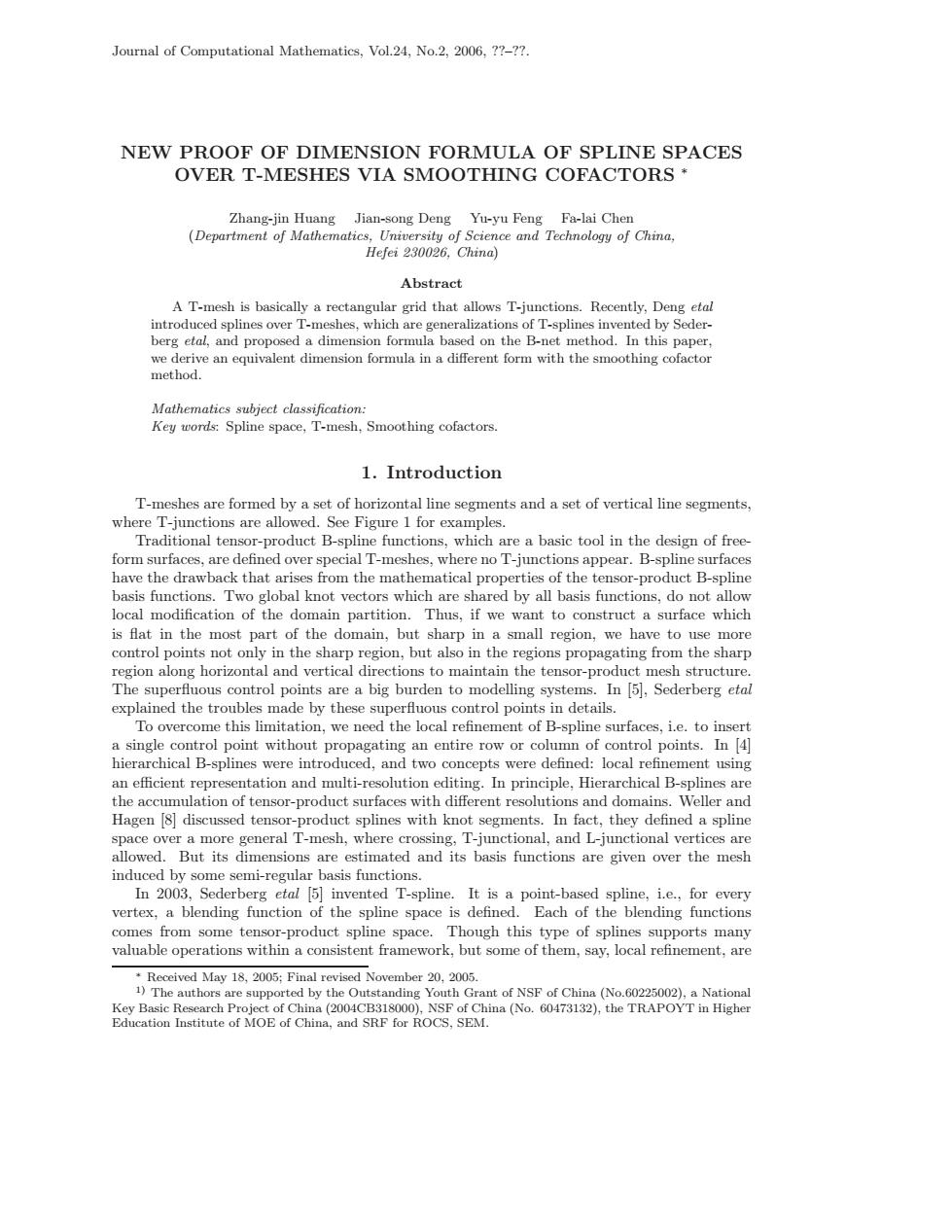正在加载图片...

Abstract ah 1.Introduction ents and a set of vertical line segmenta rof the p reg T need t al T-wsh.wheJournal of Computational Mathematics, Vol.24, No.2, 2006, ??–??. NEW PROOF OF DIMENSION FORMULA OF SPLINE SPACES OVER T-MESHES VIA SMOOTHING COFACTORS ∗ Zhang-jin Huang Jian-song Deng Yu-yu Feng Fa-lai Chen (Department of Mathematics, University of Science and Technology of China, Hefei 230026, China) Abstract A T-mesh is basically a rectangular grid that allows T-junctions. Recently, Deng etal introduced splines over T-meshes, which are generalizations of T-splines invented by Sederberg etal, and proposed a dimension formula based on the B-net method. In this paper, we derive an equivalent dimension formula in a different form with the smoothing cofactor method. Mathematics subject classification: Key words: Spline space, T-mesh, Smoothing cofactors. 1. Introduction T-meshes are formed by a set of horizontal line segments and a set of vertical line segments, where T-junctions are allowed. See Figure 1 for examples. Traditional tensor-product B-spline functions, which are a basic tool in the design of freeform surfaces, are defined over special T-meshes, where no T-junctions appear. B-spline surfaces have the drawback that arises from the mathematical properties of the tensor-product B-spline basis functions. Two global knot vectors which are shared by all basis functions, do not allow local modification of the domain partition. Thus, if we want to construct a surface which is flat in the most part of the domain, but sharp in a small region, we have to use more control points not only in the sharp region, but also in the regions propagating from the sharp region along horizontal and vertical directions to maintain the tensor-product mesh structure. The superfluous control points are a big burden to modelling systems. In [5], Sederberg etal explained the troubles made by these superfluous control points in details. To overcome this limitation, we need the local refinement of B-spline surfaces, i.e. to insert a single control point without propagating an entire row or column of control points. In [4] hierarchical B-splines were introduced, and two concepts were defined: local refinement using an efficient representation and multi-resolution editing. In principle, Hierarchical B-splines are the accumulation of tensor-product surfaces with different resolutions and domains. Weller and Hagen [8] discussed tensor-product splines with knot segments. In fact, they defined a spline space over a more general T-mesh, where crossing, T-junctional, and L-junctional vertices are allowed. But its dimensions are estimated and its basis functions are given over the mesh induced by some semi-regular basis functions. In 2003, Sederberg etal [5] invented T-spline. It is a point-based spline, i.e., for every vertex, a blending function of the spline space is defined. Each of the blending functions comes from some tensor-product spline space. Though this type of splines supports many valuable operations within a consistent framework, but some of them, say, local refinement, are ∗ Received May 18, 2005; Final revised November 20, 2005. 1) The authors are supported by the Outstanding Youth Grant of NSF of China (No.60225002), a National Key Basic Research Project of China (2004CB318000), NSF of China (No. 60473132), the TRAPOYT in Higher Education Institute of MOE of China, and SRF for ROCS, SEM